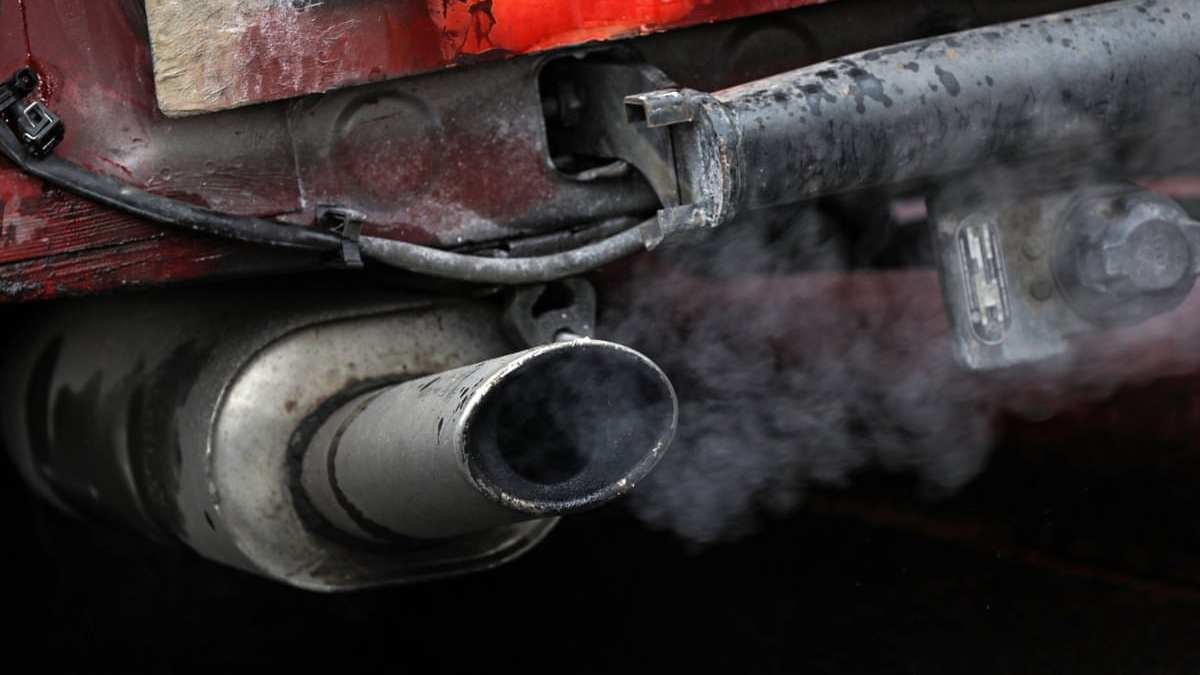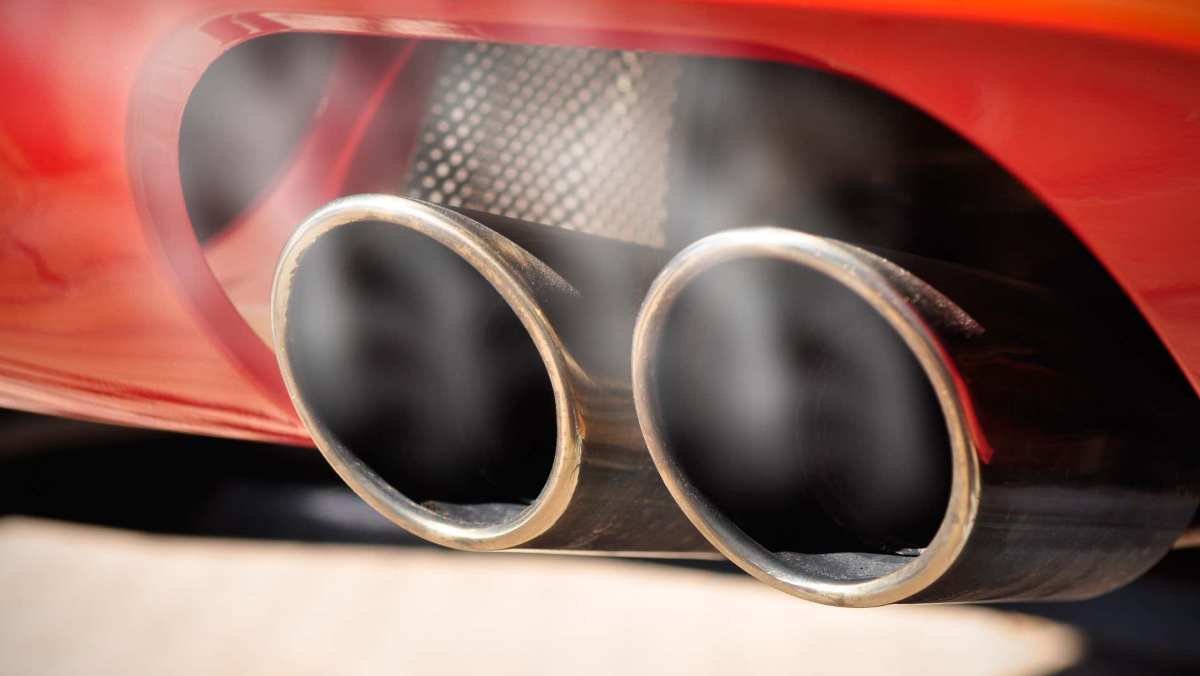Dealing with a white smoke from exhaust issue? Don’t wait to get to the bottom of it.
Let’s get something straight — if you see white smoke or any other color of smoke coming from your exhaust, there is likely something wrong with your car. The exhaust of a well-functioning vehicle should be near transparent.
For one thing, if the white smoke occurs when starting the vehicle, it may be caused by a coolant being burned in the engine; if it comes out while idling or accelerating, it could be due to a cracked intake gasket or faulty fuel injectors.
This article goes over the most common causes of white exhaust smoke and what you can or should do to fix them.
IN THIS GUIDE
What Are Exhaust Emissions?
Before we get to the causes, it helps to know what exactly exhaust emissions are. Simply put, the fumes released from the tailpipe of your gas or diesel vehicle are the byproduct of the combustion process taking place in the internal combustion engine.
An electrical spark ignites a mixture of fuel and air to get your engine moving, creating toxic gases that get funneled through the exhaust system, then through a catalytic converter where their harmful contents are reduced, and finally out through the tailpipe.
These gases greatly contribute to air pollution, global warming, and the smog that plagues many large cities, but that’s a discussion for another day.
What should exhaust emissions look like? Not a thick white plume, that’s for sure.
The exhaust that comes out of your tailpipe should be mostly transparent. It’s normal for water vapor to cause a light white color and for older engines to produce a little bit of smoke; however, a thick white smoke should be cause for alarm.
White Smoke From Exhaust On Startup
If you notice white smoke coming from your exhaust when you start the vehicle, it doesn’t necessarily indicate a problem. You will need to observe how long the lingers.
Condensation Burn Off
If the white only lingers for a few minutes and then disappears, it’s likely just water vapor caused by water residue in the exhaust pipe changing into steam as the engine heats up.
White exhaust smoke on startup caused by condensation burn-off is a particularly common occurrence in cooler environments, particularly when there is a lot of condensation and dew. It disappears after all the dew in the tailpipe dries up.
How To Fix
Condensation burn-off isn’t a problem, so there is really nothing to fix.
If the sight of white smoke coming from your tailpipe(s) bothers you, driving your car around for a short while and letting it warm up will cause it to dissipate. All you need is some patience.
This is the only instance where you can drive your car and wait out the problem without putting it at risk of damage. All the other causes of white exhaust smoke can lead to serious problems if not addressed quickly.
Damaged Coolant Reservoir Tank
If the white smoke doesn’t disappear shortly after startup and instead persists, there is likely one of several mechanical problems that can seriously damage your engine if not addressed quickly. A coolant leak is one possible cause.
While rare, a crack or puncture in the coolant reservoir tank can result in the coolant spilling on the engine block, possibly creeping into the cylinders and burning in the combustion chamber.
Not only does leaking coolant produce thick white exhaust smoke and a very noticeable smell, but it also deprives your engine of the cooling it needs to operate optimally.
How To Fix
If the coolant reservoir tank has a hole or crack, a temporary fix is to patch it up with duct tape. The crack or hole will only get worse over time, so “temporary” is the operative word in this case.
The permanent, more cost-effective solution is to replace the entire tank sooner than later.
Cracked Cylinder Head
The cylinder head connects the head gasket and engine block and contains ducts that allow coolant, fuel, and lubricating oil to flow to key parts of the engine. Since it’s normally made of aluminum, it can warp or even break when the engine overheats or there is excessive friction.
A crack in the cylinder head will, therefore, cause coolant and engine oil to leak into the cylinders and combustion chamber, resulting in the production of thick white or bluish smoke.
How To Fix
Unfortunately, there is no easy, cheap, or temporary fix for a cracked cylinder head. You will need to replace the entire unit.
While fairly straightforward, the process takes a bit of time. The cost of replacing a cracked cylinder head, including labor, typically ranges from $500 to $1000 depending on whether an aluminum or cast-iron cylinder head is used.
If you’re looking to save some money, you might be able to perform the repair yourself using a head gasket sealer, assuming the damage isn’t severe.
Cracked Engine Block
The worst-case scenario is to have a crack in your engine block. Not only is repairing or replacing it time-consuming, but it’s also very expensive.
A cracked engine block can cause coolant or other fluids such as motor oil to leak into the combustion chamber, where it burns with the air/fuel mixture and creates a thick white smoke.
This is one problem you definitely can’t afford to ignore.
How To Fix
A cracked engine block can be repaired by re-welding, cold-metal stitching, or cold-metal patching the damaged section. That is, you can weld, stitch shut, or patch the crack.
Regardless of the method you go with, the repair won’t be cheap. Since you will likely not have the necessary tools and know-how to perform it yourself, expect to spend between $2,500 and $4,000 to have a professional handle it.
White Smoke From Exhaust When Accelerating

If the white some becomes more pronounced when you accelerate, you might be dealing with a bad fuel injector, a cracked or blown head gasket, or an engine control unit (ECU) error.
These are all serious issues that you should not ignore. Let’s explore each one in more detail.
Bad Fuel Injector
The fuel injector is the device that sprays fuel into the combustion chamber of your engine. If faulty or malfunctioning in any way, it won’t get the timing or angle just right, causing the chamber to be filled with too little or too much fuel.
Common symptoms are rough starts and white tailpipe smoke.
How To Fix
If the white smoke is due to the fuel injectors being dirty or clogged, simply cleaning them with a quality fuel injector cleaner might just do the trick. If, however, the fuel injectors have gone bad, they will need to be replaced.
Cleaning or replacing fuel injectors is not overly complicated. We have a fuel injector buying guide that not only reviews some of the best fuel injector cleaners on the market but also shows you how to use one effectively.
To ensure your engine runs smoothly, always clean or replace all the fuel injectors at once rather than just one.
Cracked Head Gasket
The head gasket is a thin metal sheet found between the engine block and cylinder head(s), providing a seal between the two parts and helping prevent oil and coolant from leaking into the engine.
When there is a crack on the head gasket, the coolant in the engine’s cooling channels leaks or gets sucked into the cylinder. The coolant burns with the engine’s air/gas mixture every time you hit the accelerator, causing white or bluish exhaust smoke and possibly a misfire.
How To Fix
If the head gasket isn’t too damaged, your cheapest option is to use a professional-grade gasket sealer to plug the leak.
You pour the sealant into your car’s radiator and then put your vehicle through a 20 to 30-minute rev cycle to allow it to circulate through the engine, penetrate the cracks, and dry to form a seal.
In some cases, the crack is so big and the leak so pronounced that you have no choice but to replace the entire head gasket.
The good news is that the head gasket is one of the cheaper pieces on a car. Unfortunately, you’ll need to pay a professional a decent amount of money to have it replaced if you lack the necessary know-how.
Though a fairly straightforward process, the replacement is a very delicate procedure that can lead to serious consequences if not done right.
ECU Error
A faulty or glitchy engine control (ECU) unit can also cause white smoke to come from the exhaust when accelerating. It might send the wrong information to the fuel injector, throwing off its timing.
This of course causes too much fuel to be released and burned in the combustion chamber, producing excess smoke.
Bear in mind that the fuel injector itself isn’t bad. It’s the ECU that needs to be repaired or reprogrammed so that the fuel injector has the correct timing.
How To Fix
Repairing or reprogramming an engine control unit is usually not a task that the average person has the tools or know-how to perform. Depending on your particular vehicle, you can expect to pay a professional anywhere from $300 to $750 to have it inspected and tested and another $300 to $750 to fix any issues.
Should you be unfortunate enough to need a replacement, the cost of the ECU alone can range from $1,000 to $3,000, with the labor to replace it coming in at around $500 to $600.
Problems Arising Of White Exhaust Smoke Issue
As alluded to in the previous sections, your car or truck can sustain serious mechanical issues if the underlying cause of the white tailpipe smoke is not addressed in a prompt and timely manner.
A faulty ICU, for instance, can cause engine misfires, leading to stalling when idling or driving. You may even experience a drop in acceleration.
A coolant leak not only produces white smoke but also restricts the amount of cooling your engine needs to operate properly, causing it to overheat and possibly seize.
An overheating engine can damage the cylinder head, creating even more smoke and placing further stress on the engine.
Blown head and intake manifold gaskets can cause oil to seep into the combustion chamber and create sludge, which will prevent the pistons from moving properly and possibly even damage them.
Of course, if your engine isn’t getting enough oil due to wastage, it won’t receive proper lubrication. The excess friction created from the lack of lubrication can cause key parts to wear out or break prematurely, leading to costly repairs.
And then there is the worst-case scenario — a cracked engine block. If the crack gets big enough, it can cause the engine to stop working, possibly even permanently, and even go up in flames.
Needless to say, the engine is the heart of your car. As such, you can’t afford to ignore any white smoke it produces.
How To Stop White Smoke Coming From Your Exhaust
The best way to stop or prevent white smoke from exhaust is to have your vehicle inspected routinely. This will help ensure that its key components are always in good working condition.
More than that, routine maintenance will allow you to quickly detect and fix any problems that arise.
Remember, the engine is the most expensive part of a fossil fuel-powered vehicle. An otherwise small problem can easily snowball into a very serious problem warranting an expensive repair.
It’s not uncommon for engine repairs to be so expensive that it would be better to buy a new car rather than have the repair performed.
Once again, the best way to prevent white tailpipe smoke is to routinely maintain and inspect your vehicle and fix any problems you identify in a quick and timely manner.
White Exhaust Smoke FAQs

Why are we not surprised that you have more questions about the causes and implications of white smoke coming from a car’s exhaust? Here are answers to some popular queries about the subject.
What Does White Smoke From The Tailpipe Usually Indicate?
If you notice white smoke coming from your exhaust, even on warm days, it usually indicates that the engine is burning coolant.
Coolant leaking into the combustion cylinders and chamber often points to a cracked head gasket and/or coolant reservoir tank.
Other possible causes of white smoke include condensation burn-off, which is harmless, bad fuel injectors, a cracked cylinder head or engine block, and an engine control unit error.
Can I Drive With White Smoke From The Exhaust?
No. It’s often not recommended that you drive when there is white smoke coming from your car’s tailpipe.
The only time you can drive is if the smoke is caused by condensation burn-off. Otherwise, driving your car before the underlying cause is addressed can cause serious damage to your engine and lead to expensive repairs.
Does White Smoke Always Mean A Blown Head Gasket?
No. While a blown head gasket is a common cause of white smoke emanating from your car, it’s by no means the only cause. A cracked cylinder head or engine block, bad fuel injectors, and a damaged coolant reservoir can also lead to the production of white smoke.
On cooler days, your car or truck will produce white smoke as it heats the dew or condensation trapped in its tailpipe.
Can Bad Spark Plugs Cause White Exhaust Smoke?
No. White smoke from a car’s exhaust is not a symptom of bad spark plugs. Whitish, grayish, or bluish smoke is a fluid-related problem that’s unrelated to the operation of the spark plugs.
Such smoke usually indicates burning coolant or engine oil.
Final Thoughts
White smoke coming from your exhaust pipe is often an early warning sign of a much more serious problem with your car. We presented you with seven potential causes, each pertaining to the engine and manifesting depending on whether the car is starting up or accelerating.
Considering that the engine is the most expensive part of a gas or diesel vehicle, not taking immediate action to address the underlying cause of the white exhaust smoke can lead to costly repairs and other dire consequences.
At best you will experience poor engine performance; at worse, the engine will stop working permanently or even catch fire. Don’t let any of that happen.
Now that you know the causes of your white smoke from exhaust issue, why not check out some of our other car care articles? You might be interested in knowing how much your car weighs, how to fix a sagging headliner, and why your turn signals only work sometimes.

